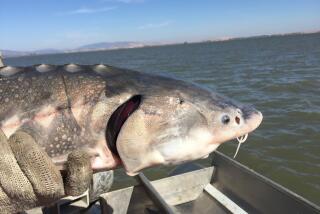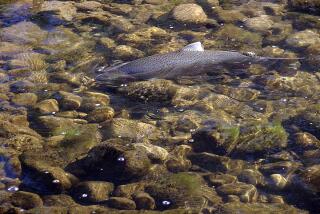Visions of Big Ones That May Not Get Away
- Share via
When I heard that Doug Elliott was planning to plant sturgeon in his lakes, I had visions of going fishing for some big ones filled with caviar.
Subsequent conversations with Elliott and Wesley Marx soon showed me the error of my thinking. What I know about sturgeon you can put in a pill bottle--the smallest size.
Yes, Elliott really is planning to put sturgeon, among the largest fish in the world, in one or more of the four private lakes he controls. He may start with Irvine Lake. Eventually, there may be sturgeon in Santa Ana, Corona and Irwindale lakes.
The problem, he explained, is obtaining this prehistoric-like creature from one of nearly a dozen commercial fish growers in Northern California. Elliott had placed a serious order with one supplier for delivery last May, but the shipment failed to show.
“It’s the law of supply and demand. Right now the demand for sturgeon has greatly exceeded the supply. They can only deliver small quantities,” he said.
He doesn’t want a few sturgeon, simply for advertising purposes. He believes in playing fair with his customers so that when they visit his lakes, they’ll have a good chance of catching a sturgeon.
When Elliott buys fish from breeders he gets 5,000 to 10,000 pounds at a time. Right now, Irvine and his other lakes are brimming with channel catfish, and some of the catch weighs in at 8 to 14 pounds. Angling for catfish will continue through October; then, when the waters cool down, he’ll plant the lakes with trout. He hopes to receive a sizable shipment of sturgeon by next year.
No, they won’t have roe--or eggs--in them. White sturgeon, the kind Elliott hopes to stock, do not spawn until they are 15 to 25 years old. His initial shipment will be immature hatchery fish. However, sturgeon can grow to enormous size. A white sturgeon caught on the Columbia River weighed in at 1,285 pounds. Most of the white sturgeon caught in San Francisco Bay aren’t over 400 pounds.
Wes Marx of Irvine has become our resident expert on sturgeon. He grew so interested in this ancient fish, whose ancestors date back at least 2 million years, that he wrote an article on them for the August issue of Smithsonian magazine.
Marx warns sturgeon neophytes like myself to forget any grandiose ideas about fishing for sturgeon in San Francisco Bay or the Sacramento River and selling its eggs to a fancy restaurant. A large sturgeon’s eggs will fetch upwards to $2,000 after they have been processed into caviar. A year in jail and a $10,000 fine is the penalty for selling a sturgeon caught in California.
Marx learned that commercial fishermen are capturing sturgeon for Serge Doroshov, who teaches animal science at the University of California, Davis. Since 1979, Doroshov has been experimenting with artificial propagation of sturgeon. His objective is to restore this potentially lucrative fishery that greed and over-harvesting have nearly destroyed. Replenishment of natural breeding stocks and establishment of viable commercial sturgeon “farms” are feasible projects. So far, the Davis project has released half a million white sturgeon fingerlings into the Sacramento River.
So I won’t be able to fish for roe-bearing sturgeon in Irvine Lake, at least not for another quarter of a century. Is the fish good to eat?
Elliott claims it is, although he admitted to not having eaten any. Marx likes it. It is appearing as a specialty item in some California and Texas restaurants.
“It’s all good solid meat,” Elliott said. “And no backbone.”
Well, that sounds like a meal, doesn’t it? Elliott has promised to keep me informed about his sturgeon project.
More to Read
Sign up for Essential California
The most important California stories and recommendations in your inbox every morning.
You may occasionally receive promotional content from the Los Angeles Times.













